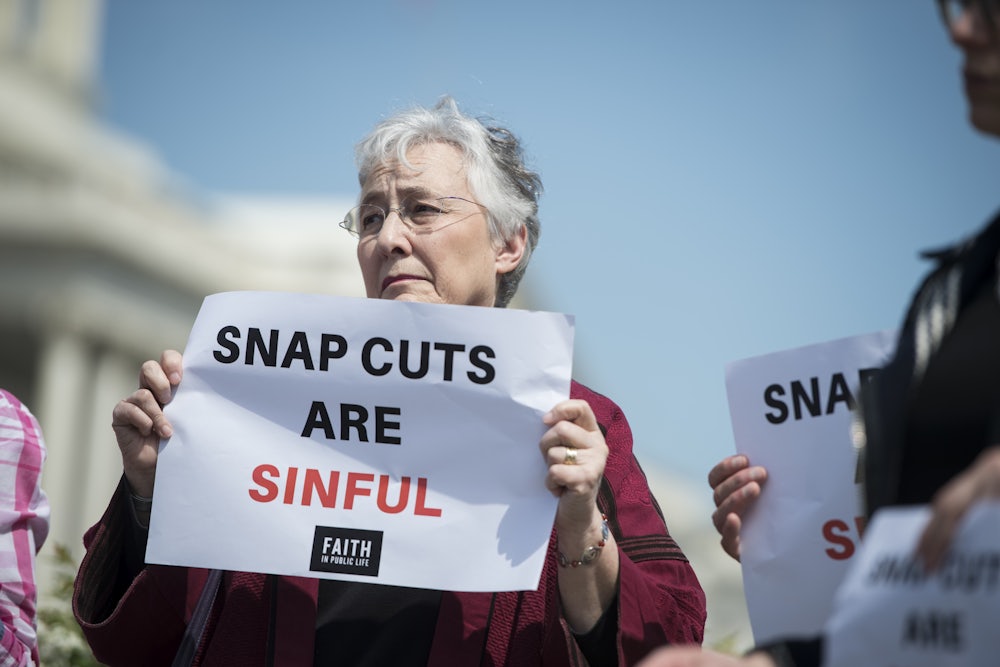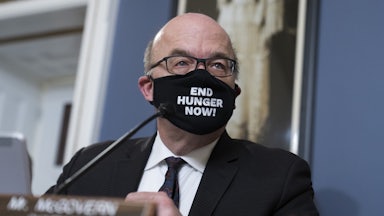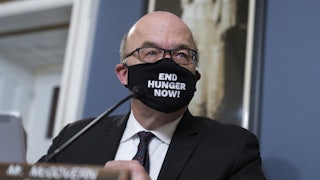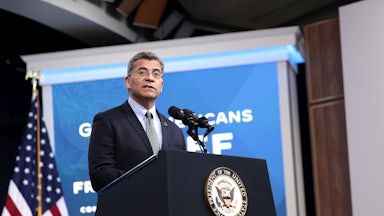A new bill introduced by Republican state lawmakers in Iowa would significantly restrict food purchases for recipients of the Supplemental Nutrition Assistance Program, or SNAP, previously known as food stamps. Among the excluded products are American cheese, white rice, baked or refried beans and fresh meat—limits to which recipients of another nutrition assistance program are already subjected.
The legislation is not a fringe proposal; it is co-sponsored by dozens of Republicans, including the state House speaker. But the bill, which garnered national headlines, represents in microcosm a larger conversation about welfare policies: questions about who should have access to such benefits and the conditions for receiving them.
What’s happening in Iowa is also a taste of turbulence to come as lawmakers in Washington prepare to reenter the ongoing debate over nutrition programs in the year ahead. A massive piece of legislation addressing agricultural and nutrition programs, colloquially known as the farm bill, is among the many high-priority tasks that the divided Congress is set to take on in the coming months. A new farm bill must be negotiated, as its previous iteration, approved by Congress in 2018, is set to expire this year. The decisions lawmakers make will be critical for Americans reliant on nutrition assistance. But SNAP has often been a point of contention in the laborious negotiations over the farm bill and is likely to be a focal point of negotiations for both parties once more.
This debate was largely set aside during the height of the coronavirus pandemic, said Donald Moynihan, the McCourt chair at the McCourt School of Public Policy at Georgetown University, when the federal government was more focused on economic stimulus. “But I think that’s coming back now, where you’re going to have lots of states, and then at the national level, look at SNAP through the lens of, ‘How can we be more aggressively involved in conditioning the benefit on satisfying a certain set of requirements?’” Moynihan said.
If past is prologue, then a fight over SNAP is in the offing: In 2018, House Republicans attempted to include provisions in the farm bill to impose new work requirements for certain SNAP recipients. The effort ultimately failed due to Democratic opposition, and the final farm bill was more similar to the one negotiated by Michigan Senator Debbie Stabenow and then–Committee Chair Pat Roberts, a Republican, in the Senate.
Republicans have a four-seat margin in the House, meaning that it may be difficult to craft legislation that can garner support from the more conservative factions in the conference. But the farm bill has traditionally been negotiated in a largely bipartisan manner on the Senate side, said Jacqlyn Schneider, a former Agriculture Committee aide who advised Stabenow on nutrition issues. “I don’t see a farm bill getting through the Senate that makes extreme changes to SNAP,” Schneider predicted.
Republican Representative Glenn Thompson, the chair of the House Agriculture Committee, told me that he did not think SNAP should be a point of contention in negotiations. “I’m optimistic that we could do a really good job in a bipartisan way with Title IV,” Thompson said, referring to the section of the bill that addresses nutrition programs. “2018 was 2018,” Thompson continued, referring to the fights over SNAP in the previous farm bill. “It’s 2023.”
The implementation of SNAP has ripple effects for recipients’ lives and the economy. The program is linked to reduced food insecurity and poverty, as well as lower health care costs. Low-income children who live in SNAP households are less likely to fall behind in school as compared to low-income children who do not live in SNAP households.
But the data demonstrating the program’s effects are not the only factor in formulating SNAP policy, as beliefs about the program are often guided by beliefs about its recipients. Research demonstrates how concepts of “deservingness” can factor into the implementation of administrative burdens—in other words, if a group of people are seen as undeserving, then people are more tolerant of setting up roadblocks to obtaining benefits. For example, if able-bodied, unemployed adults who receive SNAP and Medicaid benefits are seen as less deserving, the public may be more supportive of adding work requirements to those programs.
SNAP currently has work requirements for “able-bodied adults without dependents,” stipulating that these recipients must work or participate in a work-training program for 80 hours per month with some exceptions. If an able-bodied adult without dependents does not meet the work requirements after three months, they lose their benefits. General work requirements for other SNAP recipients vary by state but can include participating in the SNAP Employment and Training Program.
Work requirements are generally supported by the public: A recent study co-authored by Moynihan found that 51 percent of adults believed it is too easy to obtain SNAP or Medicaid, and 79 percent either agreed or strongly agreed that low-income adults should be required to work to obtain those benefits. However, the results of work requirements are mixed; a 2022 report from the Congressional Budget Office shows that SNAP work requirements “reduced income, on average, across all recipients.”
“Historically, with welfare programs, you tend to see not just opposition to the existence of those programs or eligibility expansions on the part of conservatives, but that opposition also translates into support for administrative burdens in the delivery of those services,” Moynihan said.
The national battle over the future of SNAP is echoed in more local fights over its implementation, such as the aforementioned bill introduced by Republicans in the Iowa state legislature in January. One of the bill’s co-sponsors is state House Speaker Pat Grassley, the grandson of Senator Chuck Grassley.
The bill would require SNAP recipients only to buy foods approved under another state-administered federal program, the Special Supplemental Nutrition Program for Women, Infants and Children, or WIC. Under Iowa’s current WIC guidelines, recipients must buy from an approved list of items, including specific brands and types of cereal, milk, and infant formula and food.
Limiting SNAP to items that can be purchased under WIC would complicate life for recipients who rely on SNAP for all of their nutrition needs; not only would they be required to learn what is and isn’t acceptable under 16 pages of state guidelines—strictures that WIC recipients must already know—lower-income adults and older children may not benefit as much from being limited to purchasing canned fish and infant meats. (It would also add complexity for food retailers to provide service.)
The Iowa bill would provide an additional $1 million for a program that gives people an extra $1 for food purchases for every $1 they spend on fruits and vegetables at certain grocery stores and farmers markets. However, that funding would be contingent on the Agriculture Department approving a waiver to restrict SNAP purchases. Another provision would impose an asset limit on SNAP, meaning that families with $2,750 in assets or savings, or $4,250 if at least one member of the household is age 60 or older or is disabled, would be ineligible for benefits. The measure would also require Medicaid recipients to work at least 20 hours per week. The USDA oversees SNAP and would need to approve all changes, meaning that even if the Iowa bill was passed, the federal government may not approve the waivers sought by the state to restrict SNAP; however, Iowa could try to challenge the administration in court.
Grassley defended the bill by citing the cost of SNAP. “It’s these entitlement programs. They’re the ones that are growing within the budget and are putting pressure on us being able to fund other priorities,” Grassley said. But SNAP is federally funded, and the state covers just half of administrative costs; Iowa spent around $22 million on SNAP in 2020. Meanwhile, Iowa Governor Kim Reynolds announced a nearly $2 billion budget surplus last year. Around 9 percent of Iowa’s population relies on SNAP.
Hawkeye State lawmakers are hardly the first to do such tinkering with benefits. Elements of the Iowa bill have appeared in legislation in other states, said Ellen Vollinger, the SNAP director at the Food Research and Action Center. “It is not uncommon that we see state bills that propose to weaken SNAP or to make eligibility more difficult,” Vollinger told me. But the provision restricting SNAP purchases to WIC items is more unusual. “I don’t have any idea if the members who put together that bill, or whoever put together a bill for them, had ever even thought through that list of items or had any concept that the WIC program is for pregnant and postpartum women, for infants and children up to five,” Vollinger said.
Moynihan argued that the Iowa bill exposes an undercurrent of “paternalism” common in welfare policy; essentially, the idea that poor people can’t be trusted to make decisions about their own well-being.
“If you think of the Republican Party as the party that argues for limited government [or] not a very intrusive government, that doesn’t fit with the idea [of] telling welfare recipients that they can buy a vanishingly small set of goods.… That’s incredibly intrusive in people’s lives,” Moynihan said. “In cases like welfare policy, you see people who will argue for smaller government being very comfortable with justifying a highly invasive government at the same time.”
Now that you have taken a stroll with me down Iowa’s wonky lane, let us return to Washington’s farm bill boulevard. As SNAP has “historically, over the past couple farm bills, been a tricky issue to resolve,” Schneider said, the ideological differences underpinning conversations about the program are likely to emerge again. “I don’t know that it’s necessarily because it’s food assistance,” Schneider said about disagreements over SNAP, “so much as the bigger picture of what people deserve to get from the government versus what they should be providing for themselves.”
Negotiations over the farm bill are taking shape at the same time that many SNAP recipients are facing what Vollinger calls a “hunger cliff”: the looming end of supplemental SNAP benefits known as “emergency allotments” that were established at the beginning of the pandemic.
The omnibus government funding bill that passed in December established a permanent Summer EBT program, which allows students to obtain free or reduced-price meals when school is out of session. However, Summer EBT will be partially offset by ending the SNAP emergency allotments, an average cut of $82 per person each month.
Seventeen states, including Iowa, have already ended their emergency allotments, but 32 have extended their emergency allotments program through February of this year, the last month that the supplemental benefits are available. (South Carolina has only extended its emergency allotments through January.) The emergency allotments had previously been tied to the public health emergency declared by the president in response to the pandemic.
Without the emergency allotments, the average benefit for SNAP recipients is around $6 per person per day. SNAP benefits are based on the Thrifty Food Plan, the plan used by the USDA to determine maximum SNAP allotments. Congress required USDA to reevaluate the Thrifty Food Plan as part of the 2018 farm bill, resulting in an increase in SNAP benefits in 2021. Thompson and Senator John Boozman, the ranking member of the Senate Agriculture Committee, raised concerns about the revised Thrifty Food Plan in December, citing a Government Accountability Office report arguing that the USDA made the changes “without key project management and quality assurance practices in place.”
While the Thrifty Food Plan may be a subject of negotiations in the farm bill, Vollinger argued that the cost of SNAP was still relatively low. (The nutrition title of the farm bill is by far the most expensive.) “I think the optics are going to be very strange when people want to attack the Thrifty Food Plan adjustment on the basis of, you know, lack of a charter or whatever, and people are going to be down to $6 per person a day,” Vollinger said, referring to a portion of the GAO report that critiqued the USDA for not employing a project charter.
The areas of disagreement, while not insignificant, will not necessarily derail the admittedly difficult task of negotiating a farm bill before its provisions expire at the end of September. (SNAP is a permanent program that will not expire.) “Are there some places [where] we’ve got to do some more investment across the board? There may be,” Thompson said. “I look at the value of the return on investment, and that’s how I look at the farm bill. I think there’s a huge return on investment for all the titles, including [the nutrition title].”
Thompson also highlighted the importance of SNAP education and career training efforts, particularly for formerly incarcerated people. The Agriculture Committees of both chambers will continue to conduct hearings to learn more about what is needed in the bill.
“There may be some differences on exactly what Republicans or Democrats want on some of those details. But I think that sometimes we miss in the conversation that there are Republicans that do think that SNAP is a good program and want to keep it strong,” Schneider said.










